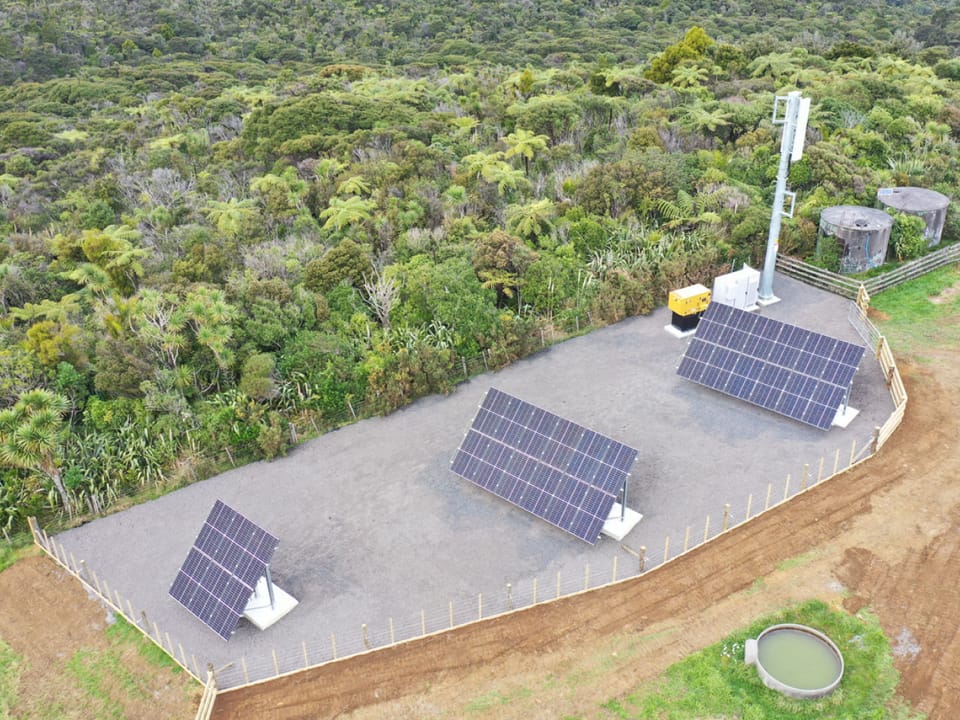Rural Connectivity Group hits 500 cell site milestone

Anawhata is the site of the Rural Connectivity Group’s 500th open access cell tower. The tower serves a coastal community sitting between Piha and Bethells on Auckland’s west coast in the Waitākere Ranges Regional Park.
Paul Mathewson, RCG chairman and chief commercial officer at 2degrees says with the addition of the 500th tower at Anawhata the organisation now connects 33,000 houses that were previously without broadband.
Last month the RCG network carried four PBs (petabytes) of data traffic and nine million voice calls per month.
Reaching the places other networks don’t
The RCG tower network also covers thousands of kilometres of rural roads and 110 tourist hotspots. There are even five RCG towers in the Chatham Islands. In that sense, the Anawhata site perfectly illustrates the purpose of the Rural Connectivity Group’s work.
The RCG is a joint venture between Spark, 2degrees and One New Zealand. It emerged at the Tuanz 2017 Rural Connectivity Symposium in Wellington as a bidder for the second stage of the government’s Rural Broadband Initiative.
This included a pool of $150 million collected from the Telecommunications Development Levy. Of that, a total of $50 million was initially earmarked to fill in cellular network coverage gaps in places where people would need connections, but were not busy enough to attract commercial tower investment.
Over time more money was added to the RCG pot including significant investment from the RCG shareholder companies and contributions from the previous government’s Provincial Growth Fund.
Open access towers
The RCG provides open access towers which the three mobile carriers, who are also the joint venture shareholders, and other interested parties can use to mount their antennae.
Mathewson describes the RCG performance as “nothing short of impressive”. He says: “These are some of the most remote sites in New Zealand – so the process to identify the sites, lease land, then get consents and build on the sites can be a long and complex process. Not to mention getting power to the sites – some are off grid and need innovative solutions using solar.”
It took the RCG a little over a year to go from 400 to 500 sites. The former Minister for the Digital Economy and Communications, Ginny Andersen took part in a formal ceremony at Lake Tarawera in April 2023 to mark the 400th Rural Connectivity Group tower.
Apple extends satellite messages with iOS upgrade
Hidden amongst the noise about Apple’s artificial intelligence announcements at this week’ WWDC24 event was news that the company is extending the iPhone’s satellite messaging capability beyond emergency calling.
When iOS 18 arrives later this year, there will be a new Messages via satellite option when an iPhone is unable to connect to a cellular network or to WiFi.
The upgrade will only apply to phones that are already capable of emergency satellite messaging. In practice that means any iPhone newer than the iPhone 14.
Apple says Messages via satellite will automatically prompt users to connect to the nearest satellite directly from a phone’s Messages app when the phone is out of reach of a cellular service. This will allow users to send and receive texts, emoji and tapbacks over iMessage and SMS.
Satellite messages will have the same end-to-end encryption as everyday iMessages.
Apple said nothing about charging for the extended service. Previously the company said its emergency calling service would remain free until “at least” November 2025.

Zoe Udy elected as Tuanz deputy chair
Tuanz board member Zoe Udy has been elected as the organisation’s deputy chair. Tristan Ilich remains the Tuanz board Chair. Udy has served on the board since 2019. She works as a client delivery manager for PaperKite in Wellington. Previously Udy spent several years as the chair of Flint (Future Leaders in Technology) Wellington. Flint was established by Tuanz.
Telecom and network API spending set for a 10x growth spurt
IDC says it expects worldwide spending on telecom and network application programming interfaces to reach US$6.7 billion in 2028. That’s close to ten times the size of the market in 2023 which IDC estimates at US$700 million.
The research organisation says the growth will come as service providers push “customised, programmable connectivity”. It says they will do this as they look to “monetise new capabilities from their network, which in turn will help to expand the overall ecosystem and market value”.
IDC IoT and telecom network infrastructure research manager Patrick Filkins says: “While the telecom industry has a mixed history of API monetisation, its latest focus on novel network APIs is being championed by all leading telecom service providers to include global support from key API aggregators, such as the hyper-scale cloud providers and leading CPaaS entities.”
Filkins says the service providers have little choice but to drive API adoption because the business of providing connectivity has been commoditised.
Nokia hypes immersive calling
Nokia’s CEO Pekka Lundmark made a phone call with immersive 3D sound.
An over-excited Jenni Lukander, president of Nokia Technologies says: “It is the biggest leap forward in the live voice calling experience since the introduction of monophonic telephony audio used in smartphones and PCs today”.
The technology sector isn’t afraid of hype, but this is ridiculous on a number of levels. For a start, the move to HD calling where you can hear speech with crystal clear clarity,
was a bigger, and from a practical point of view, more important step.
Immersive 3D sound is a nice-to-have, but it’s hardly the dawning of a new era.
In other news...
Reseller News reports the unsurprising: Government spending on contractors and consultants plummets post-Budget. The knock-on effect of this is everywhere too.
Also at Reseller News Rob O’Neill says Xero is taking a DIY approach to artificial intelligence with its Just Ask Xero smart business companion.
Of course, the current excitement about AI, at times it seems like every technology company is racing to add AI features to existing products, could be a bubble. IDC says the Australia and New Zealand market for artificial intelligence (AI) platforms software grew 62.3 per cent in the last year. This is at a time when overall software spending growth is slowing down to a positively stately, in comparison, 17.3 per cent.
At RNZ there’s a delightfully skeptical reminder that AI is capable of churning out a lot of rubbish in Fact checking Artificial Intelligence.
“We've been repeatedly told artificial intelligence (AI) will take our jobs, a mantra that in recent years changed to someone able to use the technology being the preferred hire, but is that the case”, asks Juha Saarinen at interest.co.nz. At this point you can already guess the answer is a negative.
At the Spinoff Alice Webb-Liddall looks at some local companies aiming to supply killer AI apps for lucrative niches in Meet the NZ company creating digital humans for the world’s biggest brands.
The National Cyber Security Centre is warning about a major phishing campaign targeting New Zealand. It says: “Compromised user accounts are being used to send phishing emails which may originate from trusted or known contacts. These are being sent via Microsoft OneDrive-SharePoint sharing invitations, in an effort to redirect users to malicious websites and harvest credentials or session tokens.”
Member discussion